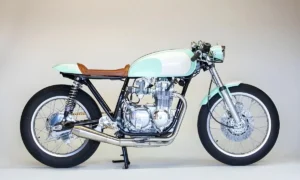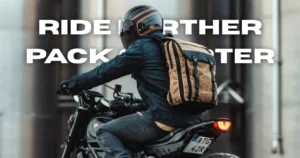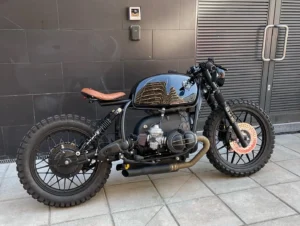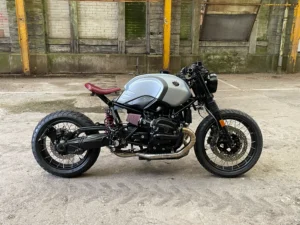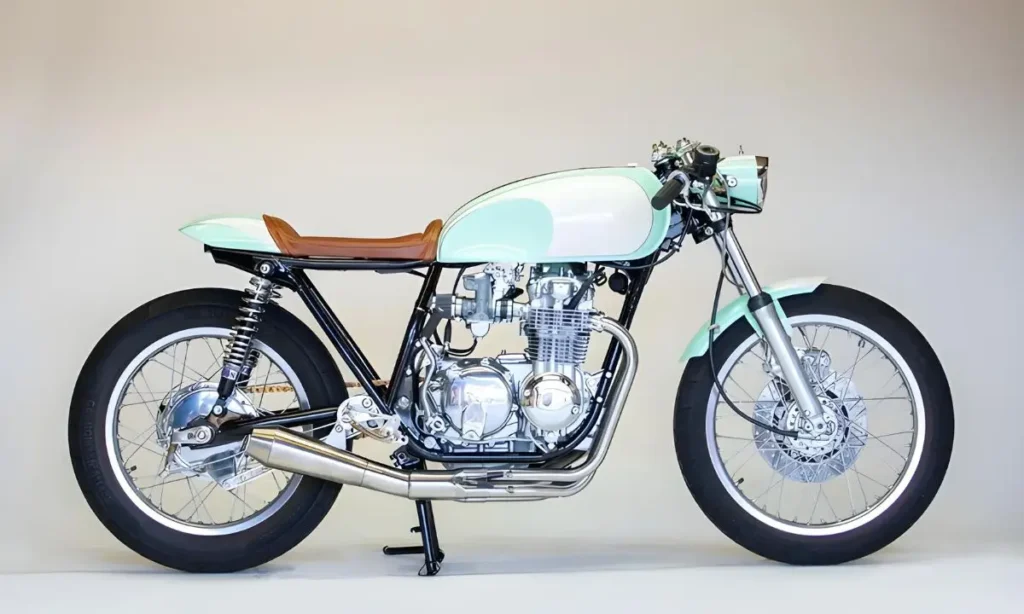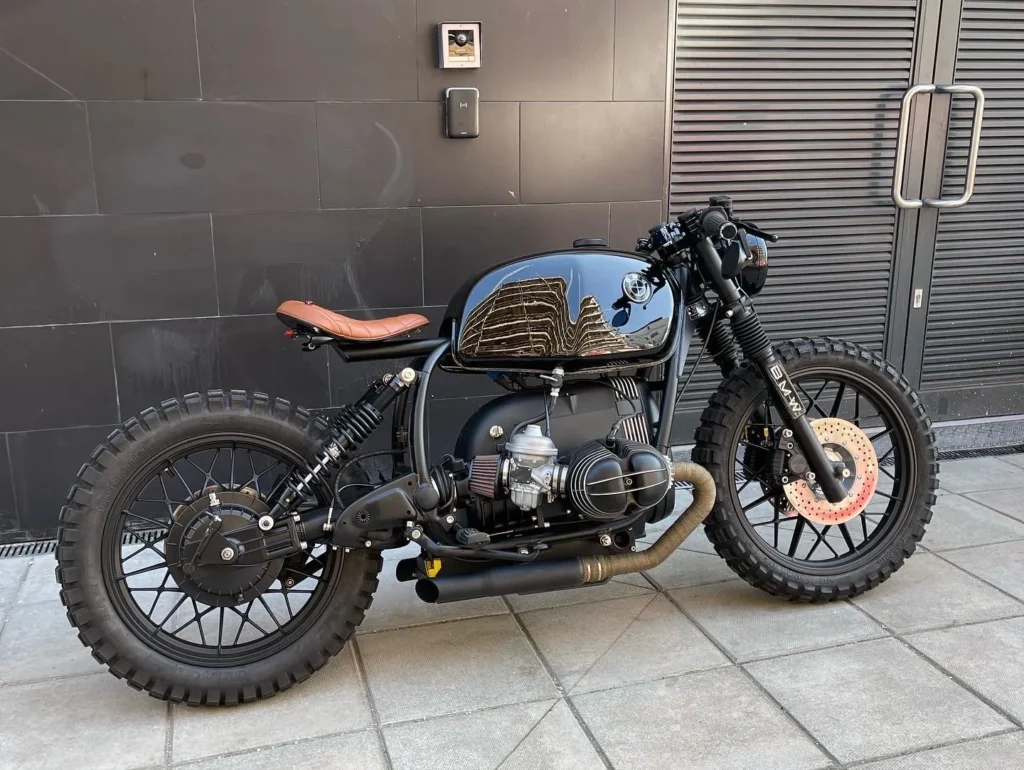Table of Contents
ToggleWhen we talk about cafe racers, few bikes show the spirit of custom builds like the BMW R80. It’s a bike that lasts through time and is great for creative changes. If you’re like me, you’ve probably spent hours looking at custom bikes online, and the BMW R80 keeps coming up. There’s a reason for that.
The BMW R80 was first made in the late 1970s and became popular for its strong build and cool look. The air-cooled boxer engine was new at the time, and even now, people love it for being simple and easy to change. But more than just being an old bike, the R80 is one of the top choices for cafe racers. Its design, history, and easy changes make it a great choice for builders and fans.
Why is the BMW R80 a Popular Cafe Racer Base?

At first, the R80 might not seem like a good choice for a light cafe racer. Its boxer engine and bigger look are different from the single-cylinder bikes usually used for cafe racers. But this is why it’s so popular. The R80’s shape and design make it great for customization.
If you want to learn more about cafe racers and why the BMW R80 is a great choice, check out our easy guide here.
The boxer engine, with its sideways cylinders, gives a smooth ride and looks different from other bikes. Many builders like how easy it is to strip down the R80. By removing extra parts, you can show off the engine and create a simple, retro look that fits the cafe racer style.

Another reason people love the R80 is its shaft drive. This system doesn’t need a chain, keeping the back of the bike clean and low-maintenance. It also gives smooth power to the wheels.
But don’t forget, the R80 wasn’t made for racing. It was built for long trips and comfort. The cool thing about turning it into a cafe racer is that it changes this touring bike into a sleek machine. So, if you’re new to bike building or an experienced rider, the BMW R80 is a great choice for your next cafe racer project.
Read More: [BMW R80G/S Cafe Racer Conversion | Guide & Tips]
Read More: [Beginner’s Guide to Cafe Racer Culture | BMW R80 Edition]
BMW R80 Specifications
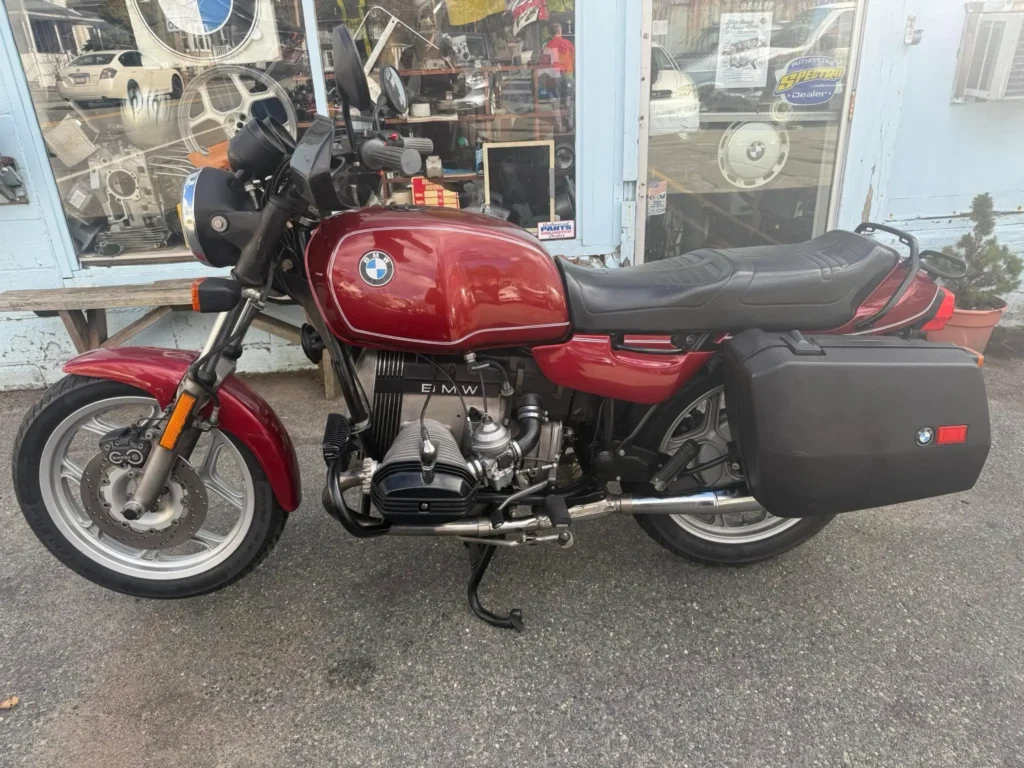
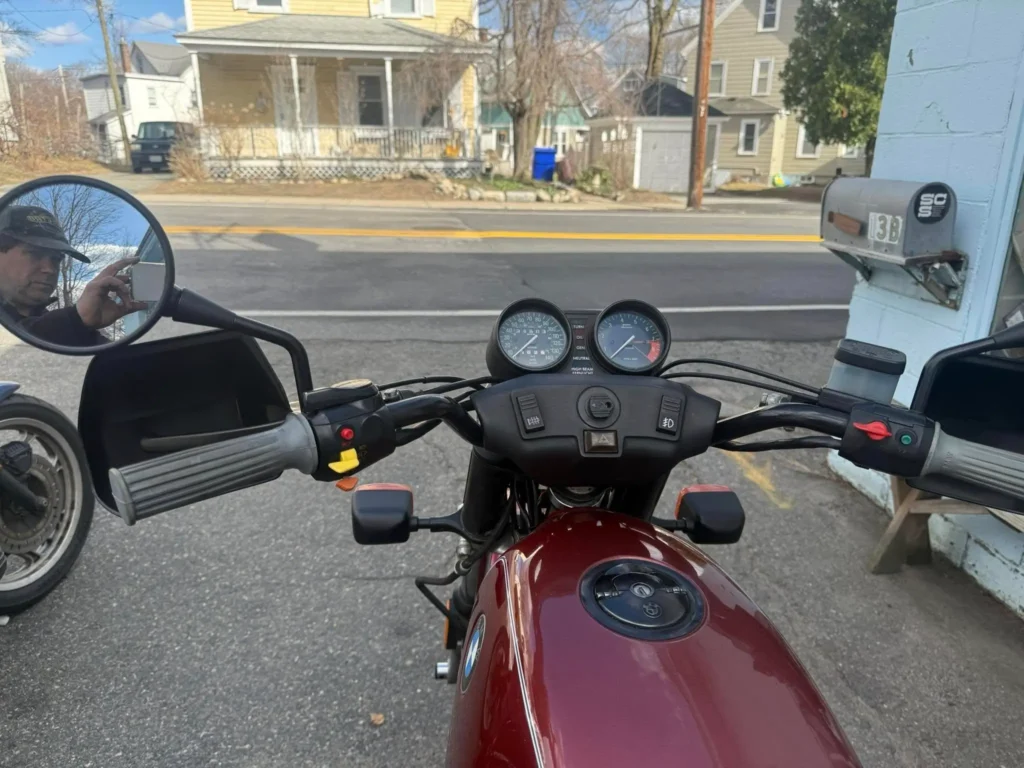

Before you start customizing the BMW R80, it’s helpful to know its original specs. This gives you a clear idea of what the bike can do and how much you can improve its performance. Here are some key stock features of the BMW R80:
- Engine: 797cc, air-cooled boxer twin
- Power Output: Approximately 50 horsepower (stock)
- Torque: 41 lb-ft
- Transmission: 5-speed manual with a dry clutch
- Weight: Around 450 lbs (dry)
- Top Speed: ~110 mph
- Brakes: Front disc, rear drum (depending on the model year)
- Suspension: Conventional telescopic front forks, twin-shock rear setup (or Monolever depending on the year)
- Fuel Capacity: 5.5 gallons (approximately)
- Shaft Drive: The R80 uses a shaft drive, eliminating the need for a traditional chain or belt.
When building a cafe racer, knowing these numbers can help you decide where to improve performance. For example, upgrading the suspension or using a Siebenrock 1000cc kit to increase engine size can boost performance a lot.
The Core Features of the BMW R80
When starting a BMW R80 Cafe Racer build, it’s important to know why this bike is great for custom work. It’s not just about removing a few parts and adding a new seat. A good build works with the bike’s strengths and makes them even better.
Engine and Performance
The heart of the BMW R80 is its boxer engine. BMW has used this type of engine since the 1920s. Unlike most bikes, where the cylinders stand upright, the R80’s cylinders stick out sideways. This setup gives the bike a low center of gravity, making the ride smooth and steady.
The R80 comes with a 797cc air-cooled engine. It may not be the most powerful, but it’s very reliable. That’s why custom builders love it. Many cafe racer builds include engine upgrades. Some people swap the R80 engine for a bigger 1000cc R100 engine. Others add better carbs, exhausts, or electronic ignition to boost performance.
For more power, builders often use aftermarket kits, like those from Siebenrock. These kits offer upgrades, such as lighter pistons and bigger cylinders. With the right parts and tuning, you can make the R80 much stronger than it was when it first came out.
Frame and Bodywork
One reason the BMW R80 is popular for cafe racer builds is its frame. It may not be lightweight, but it’s strong and easy to change. Many builders strip the bike down, removing extra parts to make it cleaner and simpler.
The subframe is often the first part to go. Builders usually cut off the back and add a new subframe for a sleek, minimalist seat. Many of these subframes come from makers like Vonzeti, who specialize in frames and seats for old BMWs.
Next, builders shape the bike to match the cafe racer style—low, fast, and aggressive. This often means swapping the seat for a custom single-seat and replacing the tank with a smaller or sharper one. The goal is to make the bike look fast and feel light.
Suspension and Handling
When building a cafe racer, upgrading the suspension is important to make the bike ride as well as it looks. The original suspension on the BMW R80 is good, but not made for racing. Many builders improve it by changing the front forks with ones from sportier bikes, like the Yamaha R6. Some also add fully adjustable shocks from brands like YSS or Wilbers.
In addition to swapping the front forks, the rear suspension is often upgraded too. Builders usually add longer shocks. This gives the bike a sharper look and better handling. Cafe racers are known for cornering, so getting the suspension right helps the bike handle well.
Key Modifications for BMW R80 Cafe Racers

Let’s talk about the fun part: the changes. One of the best things about building a cafe racer is the chance to make it your own. With the BMW R80, there are many ways to do this. Whether you want a simple, old-school look or a sharper, modern one, there are a few key areas to focus on. I’ll show you the main changes that will turn your BMW R80 into a cafe racer masterpiece.
Custom Subframes and Seat Units
One of the most important changes you can make to a BMW R80 cafe racer is the subframe. The original subframe is strong, but it doesn’t have the look of a cafe racer. The goal is to give the bike a cleaner and sharper look by removing the old subframe and adding a custom one.
Most builders cut the rear end and weld on a shorter, simpler subframe that fits the cafe racer style. A popular choice is to use a subframe from companies like Vonzeti or caferacerwebshop, which make parts for vintage bikes. These subframes often come with a slim single seat that matches the simple design.
The seat is also a big part of the look. To get the true cafe racer style, you’ll want a low, narrow seat that gets thinner at the back. This is called a “wasp tail” or “humpback” seat. It not only gives the bike a more aggressive look, but it also makes the bike lighter and easier to handle.
Exhaust System
Let’s talk about exhausts. The exhaust system is a key feature of any cafe racer. The stock exhaust on the BMW R80 works fine, but it’s bulky. That’s why it’s often replaced in custom builds. Many builders choose a lighter, cleaner system that runs along the side or under the seat.
One popular upgrade for the BMW R80 is a 2-into-1 exhaust system. It reduces weight and makes the rear look more open. Brands like Akrapovic and KessTech offer performance exhausts that not only sound great but also improve airflow and power.
Some builders prefer to make their own exhaust systems. If you like DIY projects, you might want to build one that fits your bike perfectly. Many riders also coat the exhaust with ceramic for a strong, matte black finish, which adds to the clean cafe racer look.
Braking and Suspension Upgrades
Brakes and suspension are key areas to upgrade for safety and performance. The stock BMW R80 brakes are fine for normal rides, but if you push the bike harder, you’ll need stronger ones.
Upgrading the front forks is a common change. Builders often swap the stock forks with sportier ones, like those from a Yamaha R6 or BMW K100. These forks not only look better but also improve handling and response, which is important for cornering like a true cafe racer.
For the rear, adjustable shocks from brands like YSS or Wilbers are popular. These shocks let you adjust the suspension, giving a smoother ride and better control. Cafe racers are all about the ride, and with the right suspension, you’ll see a big difference in how the bike corners and handles the road.
Electrical Overhaul
A true cafe racer build needs simpler electrics. The original wiring on a BMW R80 works well but can be bulky and outdated. Many builders choose to rewire the bike, using modern parts from companies like Motogadget.
To make the bike look cleaner, builders often hide the electrics under the seat or in a custom battery box. This removes clutter and keeps the bike looking simple. Motogadget systems like the M-Unit Blue let you control the bike’s electronics with a smartphone, making it modern without losing its vintage style.
Other popular upgrades include keyless ignition, custom switches, and LED lights. These add a modern touch while keeping the bike sleek.
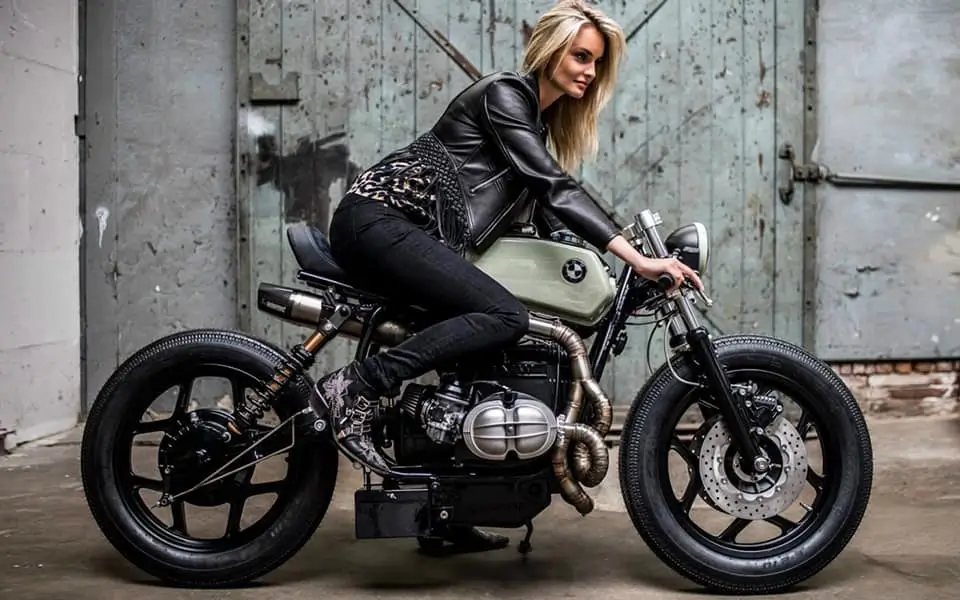
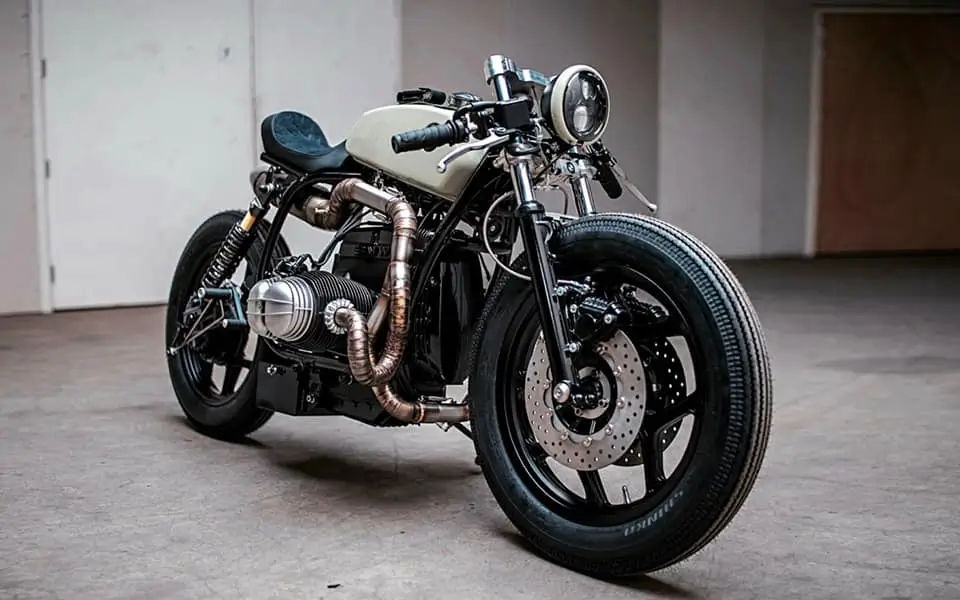
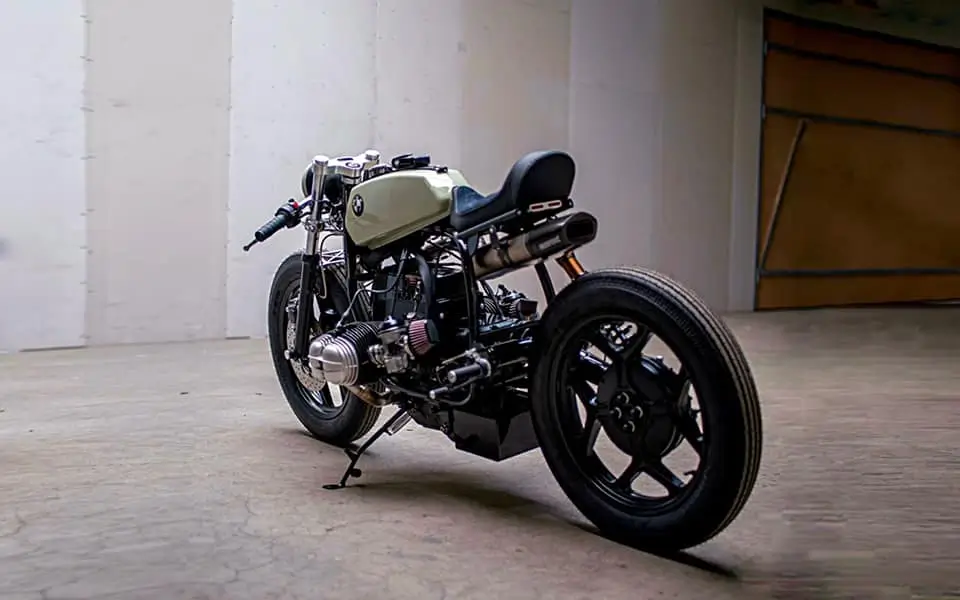
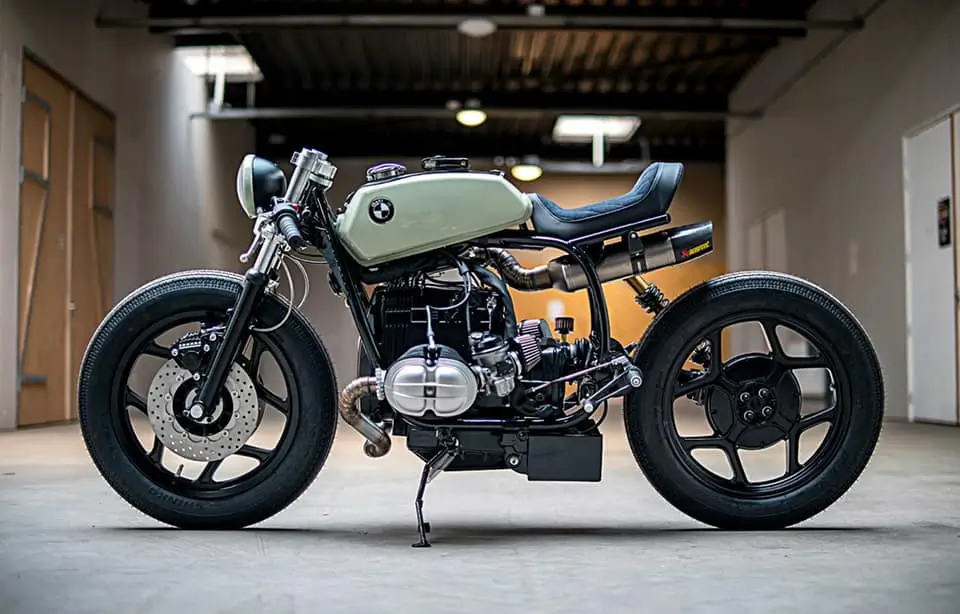
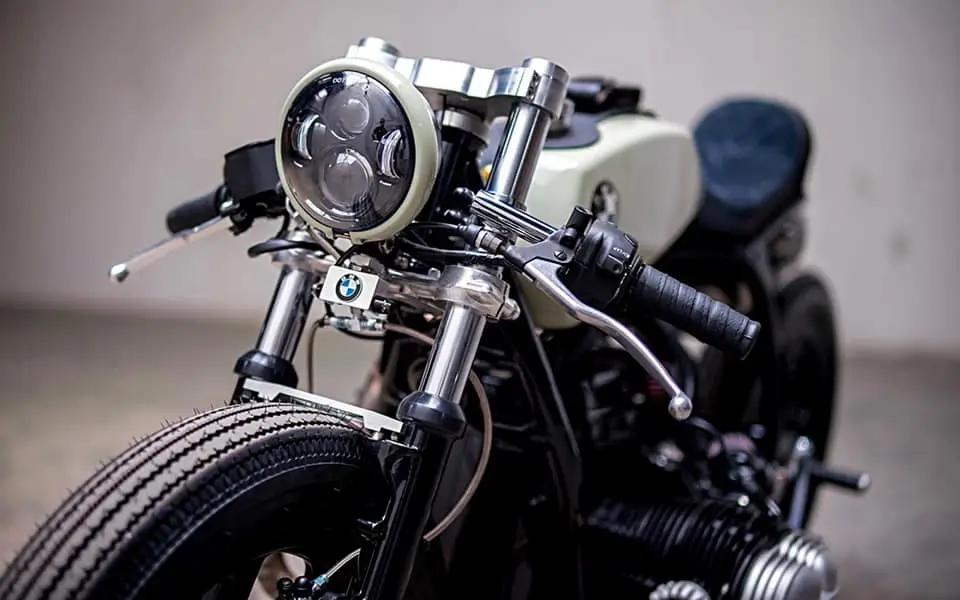

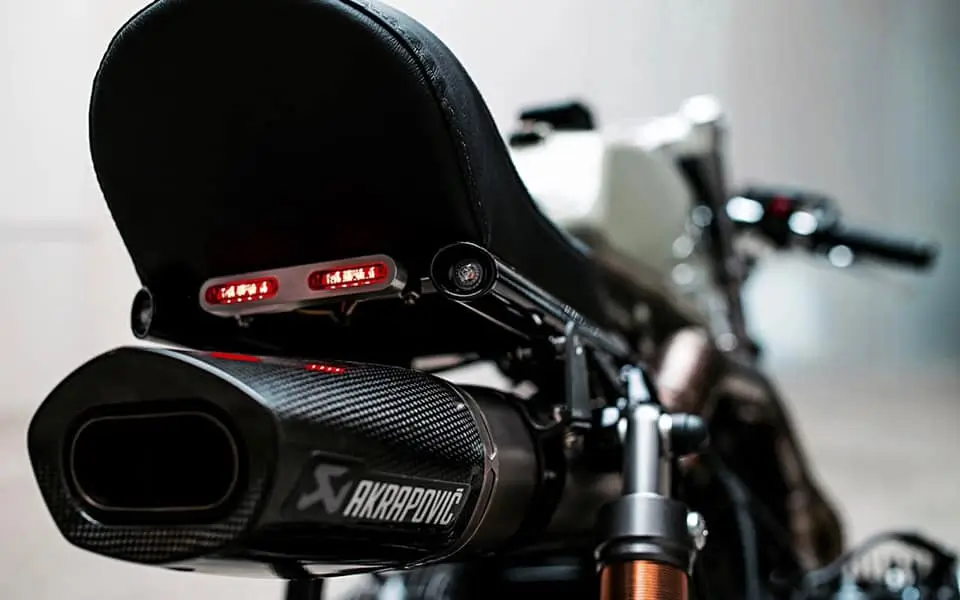
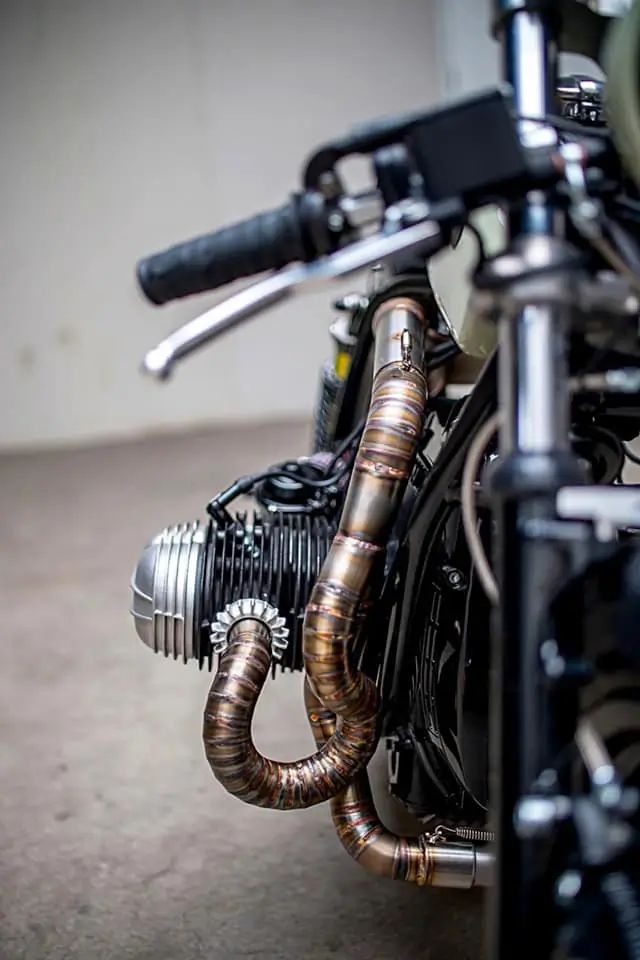



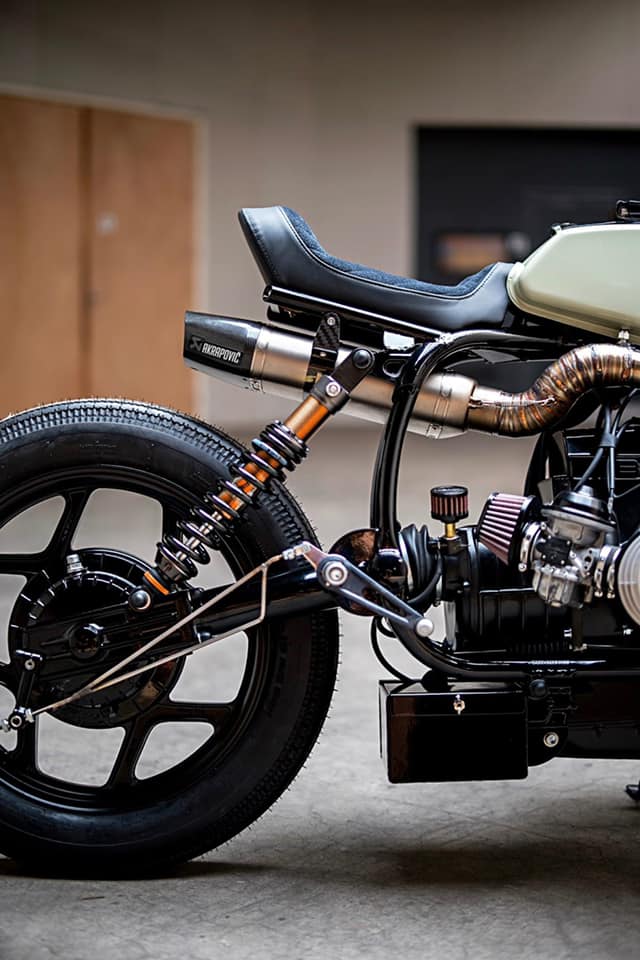
BMW R80 Cafe Racer Builds Around the World
There’s plenty of inspiration for BMW R80 cafe racer builds. From sleek, simple designs to high-performance machines, builders around the world have turned the R80 into amazing bikes. Here are some examples that might inspire your own project.
Sinroja’s BMW R80 Cafe Racer

Let’s look at the great work from Sinroja Motorcycles, a custom shop in the UK. They worked on a BMW R80, mixing old and new styles. This bike was once a police bike, but now it looks very different. Sinroja took it apart and rebuilt it from scratch. They gave it a bigger 1000cc engine, a special exhaust, and changed the suspension with Yamaha R6 forks and Nitron rear shocks.
The result? A smooth and stylish cafe racer that rides as good as it looks. Sinroja also added new features like a special wiring system from TowzaTronics and a keyless ignition from Motogadget. It’s a perfect mix of classic style and modern technology.
WalzWerk’s R80 Monolever Cafe Racer

Another amazing bike comes from WalzWerk, a custom shop in Germany known for top BMW builds. Their R80 Monolever cafe racer is simple yet stunning. They started with a 1984 BMW R80 RT and stripped it down to the frame. They then rebuilt the bike using almost 90% new parts.
WalzWerk added a 1070cc Siebenrock engine and made custom carbon fiber fairings. The bike has a sharp and clean look, with a floating subframe and sleek LED lights. They also strengthened the frame to handle the extra power, making sure this cafe racer rides just as well as it looks.
Ferry Westerlaken’s R80 Cafe Racer

For a hands-on project, check out Ferry Westerlaken’s DIY BMW R80 Cafe Racer. Ferry built this bike while working full-time and staying busy. But he still created a beautiful machine. One cool feature is the custom exhaust, which he made himself with special tubes that fit the bike perfectly.
The bike also has a rebuilt engine, a custom subframe, and performance parts like Tarozzi rear sets and a Vonzeti seat. This build shows what you can achieve with hard work, creativity, and some effort.
Read More: BMW R100 vs R80 | Which Model Makes the Best Cafe Racer? [Comparison Guide]
Read More: [BMW R80 vs Other Classic Cafe Racers | Which is Right for You?]
Building Your Own BMW R80 Cafe Racer
So, you’re inspired and have seen some amazing custom builds. Now, you’re ready to start your own BMW R80 Cafe Racer project. It may feel like a lot at first, but don’t worry—I’ve been there too. Whether you’re doing this on weekends or full-time, there are a few key steps to help make sure your project goes smoothly.

Choosing the Right Donor Bike
The first step in building a cafe racer is finding the right bike. For the BMW R80, most models are good options, but there are a few things to check first.
Start by looking at the bike’s condition. If it’s been sitting unused for years, you may need to do a lot of work. This can include replacing old parts and maybe even rebuilding the engine. Some people enjoy this part of the project.
If you find an R80 that still runs, you’ll save time and effort. Be sure to check the frame and engine for any big issues. Small rust spots or minor damage can be fixed, but large frame damage can cost a lot to repair.
BMW R80 models from the late ’70s to mid-’80s are great picks. The R80 Monolever models are lighter and simpler than older dual-shock models. Whatever version you choose, make sure to test the engine, frame, and transmission to start with a solid bike.
Parts Sourcing and Budgeting
Let’s be honest: building a custom cafe racer can get expensive if you’re not careful. But with good planning, you can keep costs low and still build your dream bike.
Here’s a tip I’ve learned—don’t rush to buy parts. Some of the best parts are cheaper if you’re willing to look around. Try online marketplaces, forums like BMW MOA, or specialty sites like Beemer Boys and Motogadget.
You’ll also need to decide if you want original BMW parts or aftermarket parts. Siebenrock makes high-quality parts for vintage BMW bikes, like engine kits and suspension upgrades. These parts cost more, but they’re worth it if you want better performance.
When planning your budget, remember to leave room for surprise costs. Parts can cost more than expected, and you might find mechanical problems along the way. A full custom BMW R80 Cafe Racer build can cost between $5,000 and $15,000, depending on how much work you do yourself.
Cost Breakdown of a BMW R80 Cafe Racer Build
Building a cafe racer is not just about creativity and skill—it also involves budgeting. Here’s a simple cost breakdown for common changes to a BMW R80 Cafe Racer. The costs can change depending on where you buy your parts and whether you do the work yourself or hire someone.
1. Donor Bike:
- Cost: $2,500 – $5,000
- Depending on the condition and year of the bike, a BMW R80 in decent shape will generally fall into this range. The R80 Monolever models might fetch a higher price due to their popularity for custom builds.
2. Custom Subframe and Seat Unit:
- Cost: $500 – $1,200
- A custom subframe and seat unit from suppliers like Vonzeti or a DIY solution will be necessary to achieve that sleek cafe racer look.
3. Suspension Upgrades:
- Cost: $800 – $2,000
- Upgrading the front forks with those from a Yamaha R6 or similar bike, along with installing adjustable rear shocks from YSS or Wilbers, is crucial for improving handling.
4. Exhaust System:
- Cost: $400 – $1,500
- A 2-into-1 custom exhaust from Akrapovic, KessTech, or a DIY fabricated system will reduce weight, improve airflow, and give the bike that aggressive sound.
5. Engine Upgrades:
- Cost: $1,000 – $3,000
- For more power, you might install a Siebenrock 1000cc kit, performance carbs, or a custom ignition system from Motogadget.
6. Electrical Overhaul:
- Cost: $600 – $1,500
- A full rewire of the bike with a Motogadget M-Unit Blue and modern lighting (LED indicators, bar-end turn signals) can simplify the bike’s electronics and enhance its minimalist appeal.
7. Wheels and Tires:
- Cost: $500 – $1,200
- Spoked wheels and tires such as Firestone Champion Deluxe can enhance both the bike’s aesthetic and performance.
8. Paint and Finishing:
- Cost: $500 – $2,000
- A custom paint job and detailing will give your cafe racer a unique and polished look. This can vary significantly depending on whether you go for a DIY job or hire a professional.
Total Estimated Cost:
$5,000 – $15,000, depending on how extensive the modifications are and whether you do the work yourself.
Step-by-Step Guide to Building a BMW R80 Cafe Racer

Now, let’s get to the fun part—building your bike! Here’s a quick guide:
- Stripping the Bike: Start by removing all the extra parts. Take off the fenders, seat, subframe, and other unnecessary pieces. This lets you see the frame and engine to check their condition.
- Working on the Frame: Once the bike is stripped, focus on the frame. Many builders remove extra brackets and mounts to clean up the look. If you’re swapping the subframe, now is the time to cut off the old one and weld on a new one for your custom seat.
- Engine Work: Depending on the engine’s condition, you may need to do a basic tune-up or a full rebuild. Some common upgrades include installing a 1000cc kit for more power, adding performance carbs, or swapping in a new camshaft.
- Upgrading the Suspension: To turn your BMW R80 into a real cafe racer, upgrading the suspension is key. Many builders swap out the front forks for sportier ones, like those from a Yamaha R6. In the back, installing adjustable shocks will improve handling.
- Custom Exhaust: A cafe racer needs a good exhaust system. Many people choose a 2-into-1 custom exhaust, like the ones from Akrapovic or KessTech. These not only look better but also improve the bike’s sound and performance.
- Simplifying the Electrical System: A simpler electrical setup is important for the cafe racer style. A custom wiring harness and a modern battery box can hide most of the bike’s electrics. Choose minimalist LED lights to keep the look clean.
- Final Assembly and Details: After the big jobs are done, it’s time to put everything back together. Pay attention to details—paint, custom seats, handlebars, and mirrors let you add your personal touch. Many builders also add clip-ons, rear sets, and custom instruments for a sportier ride.
How to Upgrade the Look and Performance of Your BMW R80 Cafe Racer?
When building a cafe racer, the look is just as important as how it runs—maybe even more. Of course, you want your bike to run well, but style is key for a cafe racer. The BMW R80 is a great bike to upgrade both its looks and performance.

Paint and Finish
One of the easiest ways to make your BMW R80 Cafe Racer unique is through the paint job. You can go for a classic, vintage look or choose bold, modern colors. There are many choices. Some builders like to use two colors, often mixing a matte color with pinstripes for a stylish touch.
Recently, matte black or satin finishes have become popular. Builders often add exposed metal to give the bike a tough, industrial feel. Some also like the patina finish, which makes a new bike look old and worn, even though it’s fresh from the shop.
Don’t forget the details! Custom badges, painted logos, and shiny chrome can make your bike feel even more personal.
Wheels and Tires
Tires are often ignored, but they are very important for a custom build. For a cafe racer, you need tires that look good and work well. A popular option is the Firestone Champion Deluxe. These tires look old-school, but they perform like modern tires.
Many builders also change the wheels. They often choose spoked rims instead of the stock alloys. Spoked wheels not only look more classic but are also stronger. This is helpful if you ride hard. Some builders even powder-coat the rims to give them a smooth and matching look.
Custom Lighting Solutions
A simple approach works best for lighting. LED headlights, tail lights, and turn signals are popular with cafe racer builders. They provide modern features while keeping the bike looking clean. Bar-end turn signals are a smart way to add indicators without making the front of the bike look busy.
To keep things even cleaner, many builders add the rear light into the frame or seat. This makes the back of the bike look simpler and improves the overall design.
Legal Considerations and Riding a Cafe Racer

While upgrading the look and performance of your BMW R80 Cafe Racer is fun, there are important legal rules to follow before riding. Laws can be different depending on where you live, so it’s important to check. Let’s go over the key legal points to make sure your cafe racer is safe and legal for the road.
Legal Requirements for Road Use
When turning a classic BMW R80 into a cafe racer, make sure it follows your country’s vehicle laws. Many rules focus on safety, emissions, and noise levels. Some key areas you should check include:
- Lighting: Cafe racers often use custom LED headlights and taillights. Make sure they meet legal rules for brightness and visibility. In many places, working turn signals and a brake light are required, even if your design is minimalist.
- Exhaust Noise Regulations: Custom exhausts are a key part of the cafe racer look, but many places have strict rules on how loud your bike can be. In some countries, like Germany, noise limits are very strict. Your exhaust may need baffles or adjustable flaps, such as those from KessTech, to stay legal.
- Registration and Frame Modifications: When you change the frame of a motorcycle, like cutting the subframe or adding new parts, it could affect its registration. In some places, big changes to a bike mean it needs extra checks to make sure it’s safe to ride. Always check if your changes affect how the bike is classified. You might need more paperwork or an inspection.
- Brake Systems and Suspension: Upgrading your suspension or brakes can boost your bike’s performance. But make sure the new parts meet safety rules. Check if they are approved for road use in your country. For example, in the UK, bikes over a certain age need an MOT test every year. Changes to the brakes or suspension might affect whether your bike passes the test.
Insurance Considerations
It’s important to have proper insurance for your BMW R80 Cafe Racer. Custom bikes can be hard to insure, especially if you’ve made big changes to the frame, engine, or electrics. Here’s what you need to know:
- Modifications Declaration: When insuring a modified bike, you must list all major changes. If you don’t, your insurance might not cover you in case of an accident.
- Valuation: Custom cafe racers often have costly parts and take a lot of work to build. It’s important to get the right valuation for your bike. Some insurers offer plans for custom or classic bikes. This ensures that if something happens, you’ll get the full value of your build.
- Agreed Value Insurance: This lets you and the insurer agree on a set value for the bike. This is helpful for custom builds, which are often worth more than a stock BMW R80.
Practicality for Daily Use
A BMW R80 Cafe Racer can grab attention, but if you plan to ride it every day, you should think about how practical it is. These bikes are made for style and speed, but comfort can sometimes be less important. Here are a few things to keep in mind if you want to ride a cafe racer often:
- Riding Position:
Cafe racers have a low and aggressive riding stance with low handlebars and rear sets. While it looks cool, it might not feel great on long rides. If you’re using the bike to commute or take long trips, consider adjusting it to be more comfortable. - Weather Protection:
Most cafe racers don’t have windshields or covers to protect you from the weather. This means you’ll feel the wind and rain. If you live where the weather changes a lot, this can make riding harder. You might want to add a small windshield to stay a bit more protected. - Maintenance:
Older bikes like the BMW R80 need regular care, especially if they’ve been changed a lot. You’ll probably need to service it more than you would a modern bike, especially if the engine has been upgraded or you’ve added custom parts. Keep in mind that finding old BMW parts can take time, so it’s important to check the bike often and fix things early.
Conclusion
Building a BMW R80 Cafe Racer is more than just fixing a bike. It’s a way to show your style, passion, and creativity. Maybe you love the sleek look of a custom frame, the sound of a new exhaust, or the fun of improving a classic engine. The R80 is a great bike to make your own.
This project is exciting and worth it, though it has its tough moments. You’ll need to find the right parts, stay on budget, and make sure your bike is legal for the road. But these are all part of the fun. In the end, nothing feels better than riding a bike you built yourself, knowing it’s one of a kind.
Whether you’re just starting or already working on it, remember: a BMW R80 Cafe Racer is more than a motorcycle—it’s a statement. Take your time, enjoy the process, and most of all, ride safely.
FAQs
What makes the BMW R80 a good base for a cafe racer build?
The BMW R80 is a top pick for cafe racer builds. It has a strong engine, a sturdy frame, and is easy to customize. The engine’s design gives it a unique look and helps keep it balanced. The shaft-drive system means less upkeep. Its simple mechanical design also makes it easy to modify. The R80 can be upgraded for both speed and style, letting builders turn it into a cool, vintage cafe racer.
How much does it cost to build a BMW R80 Cafe Racer?
Building a BMW R80 Cafe Racer can cost between $5,000 and $15,000. The price depends on several things. If you buy a used R80 in good shape and do most of the work yourself, it can be more affordable. But if you choose expensive parts, like suspension upgrades or a 1000cc kit, or pay for custom work, the cost will go up. Be sure to budget for any surprise costs, especially if the bike needs repairs.
What are the most important modifications for turning a BMW R80 into a cafe racer?
Key modifications for a BMW R80 Cafe Racer include:
Custom subframe and seat unit: To achieve the classic cafe racer silhouette.
Exhaust system: Switching to a custom 2-into-1 exhaust for performance and aesthetics.
Suspension upgrades: Upgrading the front forks and rear shocks to improve handling.
Simplified wiring and electrics: Rewiring the bike with modern components from brands like Motogadget.
Braking system: Upgrading to more powerful brakes, often with components from Brembo.
Can I ride a BMW R80 Cafe Racer daily?
Yes, you can ride a BMW R80 Cafe Racer every day, but think about comfort and how practical it is. The low handlebars and rear sets of the cafe racer can feel uncomfortable on long rides. Plus, its simple design doesn’t offer much weather protection or storage space. If you want to use it for daily commuting, you may want to adjust the seat and handlebars for more comfort. Also, consider adding a small windshield to protect you from the weather.
What is the best year/model of BMW R80 for a cafe racer conversion?
The BMW R80 Monolever models from the mid-1980s are great for cafe racer builds. They are lighter than older models and have simpler rear suspension, making them easier to customize. But all R80 models from 1978 to 1995 have strong engines and solid frames. This makes them good for customization too. The choice usually depends on what’s available and the bike’s condition.
Do I need special tools to build a BMW R80 Cafe Racer?
While you can complete many parts of the build with standard hand tools, a few specialized tools will make the process easier. For example, if you’re working on the suspension or engine, you may need a spring compressor for shock installation, and a torque wrench for precise measurements. If you’re modifying the frame, a welding machine will be essential. Access to motorcycle lifts, a tire changer, and diagnostic tools (like those from Motogadget) is also helpful if you’re doing a deep rebuild.
How can I increase the performance of my BMW R80 Cafe Racer?
There are several ways to increase the performance of your BMW R80:
Upgrade the engine: Installing a Siebenrock 1000cc kit will increase displacement and power.
Improve carburetion: Swapping the stock carburetors for aftermarket performance units, like Mikuni carbs, can enhance throttle response and power delivery.
Install a custom exhaust: A 2-into-1 system can improve airflow and increase horsepower while also reducing weight.
Electronic ignition: Adding a modern electronic ignition system from Motogadget ensures more reliable starting and smoother power delivery.
Are there any legal issues with modifying a BMW R80?
Yes, modifying a BMW R80 can lead to legal issues if not done properly. You need to ensure that your bike complies with local road regulations. Key areas of concern include:
Exhaust noise levels: Many countries have laws about how loud your exhaust can be. Custom exhausts need to meet these requirements.
Lighting and indicators: Ensure that the bike has legal headlight, tail light, and turn signal setups that comply with local regulations.
Frame modifications: If you cut or weld the frame, it may require inspection to ensure the bike remains roadworthy and legal.
Where can I find parts for a BMW R80 Cafe Racer build?
You can find parts for a BMW R80 Cafe Racer from several sources:
Aftermarket suppliers: Companies like Siebenrock, Motogadget, and YSS Suspension offer performance and replacement parts specifically for vintage BMW motorcycles.
BMW forums and online communities: Sites like BMW MOA and Adventure Rider often have classifieds sections where you can find used or hard-to-find parts.
Specialty shops: Websites like caferacerwebshop and Vonzeti sell custom subframes, seats, and other cafe racer-specific parts.
What’s the difference between a BMW R80 and an R100 for cafe racer builds?
The main difference between the BMW R80 and R100 is the engine size. The R100 has a 1000cc engine, giving it more power than the R80’s 797cc engine. People who want more speed often pick the R100. But the R80 is lighter and easier to find in good condition, so it’s popular for cafe racers. Some builders put an R100 engine into an R80 frame to combine the strengths of both bikes.



